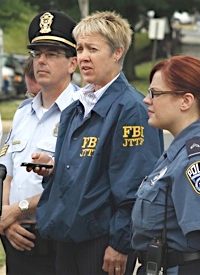
Many observers have long detected a fishy odor about the domestic terrorism plots the Federal Bureau of Investigation has busted, often to great fanfare, over the last decade. Frequently it appears that the government, through its informants, instigates the plots just so it can turn around and take credit for having stopped them in their tracks, thereby protecting Americans and, in the words of Glenn Greenwald, “proving both that domestic Terrorism from Muslims is a serious threat and the Government’s vast surveillance power — current and future new ones — are necessary.”
Now, thanks to a yearlong investigation by Mother Jones and the Investigative Reporting Program at the University of California-Berkeley, those suspicions have been vindicated. Having “examined prosecutions of 508 defendants in terrorism-related cases,” Trevor Aaronson writes, the investigative team found that the FBI “now maintains a roster of 15,000 spies” — plus as many as 45,000 unofficial ones — “as part of a domestic intelligence apparatus whose only historical peer might be COINTELPRO, the program the bureau ran from the ‘50s to the ‘70s to discredit and marginalize organizations ranging from the Ku Klux Klan to civil-rights and protest groups.”
COINTELPRO was “secretly launched in 1956 with the excuse that it could defeat communism only by matching its tyranny and evil,” as Becky Akers put it. It nearly managed to achieve that objective, Akers added, by using such tactics as “wiretapping; smearing of citizens neither arrested for nor charged with any crime; planting propaganda with the media; encouraging folks to fear the Feds had infiltrated their organizations as well, however harmless or innocent; even assassinations.” The evidence provided by Aaronson suggests that the 21st-century version of COINTELPRO is well on its way to becoming just as vile as the original.
Although “shady informants … are as old as the FBI itself,” Aaronson notes, the present, massive informant program, like so many other government depredations, owes its existence to that fateful day in 2001:
Shortly after 9/11, President George W. Bush called FBI Director Robert Mueller to Camp David. His message: never again. And so Mueller committed to turn the FBI into a counterintelligence organization rivaling Britain’s MI5 in its capacity for surveillance and clandestine activity. Federal law enforcement went from a focus on fighting crime to preventing crime; instead of accountants and lawyers cracking crime syndicates, the bureau would focus on Jack Bauer-style operators disrupting terror groups. [Emphasis in original.]
Over the last several years, Aaronson says, the FBI has turned its attention from monitoring large terrorist networks such as al-Qaeda to “identifying and neutralizing potential lone wolves before they move toward action.”
To that end, FBI agents and informants target not just active jihadists, but tens of thousands of law-abiding people, seeking to identify those disgruntled few who might participate in a plot given the means and the opportunity. And then, in case after case, the government provides the plot, the means, and the opportunity.
Here’s how it works: Informants report to their handlers on people who have, say, made statements sympathizing with terrorists. Those names are then cross-referenced with existing intelligence data, such as immigration and criminal records. FBI agents may then assign an undercover operative to approach the target by posing as a radical. Sometimes the operative will propose a plot, provide explosives, even lead the target in a fake oath to Al Qaeda. Once enough incriminating information has been gathered, there’s an arrest — and a press conference announcing another foiled plot.
Aaronson names a few of the most famous so-called terrorist bombing plots that fit this pattern: the Washington Metro plot, the New York subway plot, the Sears Tower plot, and the Portland Christmas tree-lighting plot.
Mother Jones and Berkeley investigators uncovered several important details about the FBI’s informant program:
First, of the 508 defendants whose cases they investigated, “nearly half the prosecutions involved the use of informants, many of them incentivized by money … or the need to work off criminal or immigration violations,” according to Aaronson. Needless to say, those already inclined to flout the law are also unlikely to concern themselves with the ethicality or legality of the actions the government asks them to take, especially if cooperating with the feds keeps them out of jail or in the United States.
Second, “sting operations resulted in prosecutions against 158 defendants,” Aaronson writes. “Of that total, 49 defendants participated in plots led by an agent provocateur — an FBI operative instigating terrorist action.” As Martin Stolar, a lawyer who represented a man caught in a 2004 sting involving New York’s Herald Square subway station, told Aaronson, “The problem with the cases we’re talking about is that defendants would not have done anything if not kicked in the a** by government agents. They’re creating crimes to solve crimes so they can claim a victory in the war on terror.” Doing so creates such marvelous publicity for the government that, Aaronson remarks, “President Obama’s Department of Justice has announced sting-related prosecutions at an even faster clip than the Bush administration.”
Third, “with three exceptions, all of the high-profile domestic terror plots of the last decade were actually FBI stings,” reports Aaronson. “The exceptions,” he explains, “are Najibullah Zazi, who came close to bombing the New York City subway system in September 2009; Hesham Mohamed Hadayet, an Egyptian who opened fire on the El-Al ticket counter at the Los Angeles airport; and failed Times Square bomber Faisal Shahzad.” It’s worth noting that the FBI managed to thwart only one of these plots, that of Zazi, and then only because Scotland Yard caught on to Zazi’s plot and informed the bureau. Hadayet, meanwhile, was gunned down by LAX security guards; and Shahzad was foiled by his own ineptitude, his smoldering but undetonated car bomb spotted by street vendors. Cynics wonder how many terrorist plots FBI informants were busy instigating while genuine plots went undetected by the bureau.
Fourth, says Aaronson, “in many sting cases, key encounters between the informant and the target were not recorded — making it hard for defendants claiming entrapment to prove their case.” This happened, for example, in the Portland case, where, according to the FBI, “technical problems” prevented the recording of the one conversation between the informant and Mohamed Osman Mohamud, the “terrorist” the informant had created, that would have proven whether or not Mohamud had been entrapped. What happens when the defense tries to bring up such conversations in court? According to Aaronson, “the FBI and prosecutors will instead rely on the account of an informant with a performance bonus on the line” — and one doesn’t have to be Perry Mason to figure out whose side the informant’s testimony is going to favor.
Fifth, “terrorism-related charges are so difficult to beat in court, even when the evidence is thin, that defendants often don’t risk a trial,” Aaronson maintains. “Nearly two-thirds of all terrorism prosecutions since 9/11 have ended in guilty pleas,” he adds, “and experts hypothesize that it’s difficult for such defendants to get a fair trial.” That’s good news for the government, which gets another notch on its belt, but bad news for justice.
One common thread in many of the informant-driven plots is that many of the participants, informants and non-informants alike, do so far less out of ideology than out of a simple desire for dough. One informant, for instance, got paid $100,000 per assignment. The FBI gave Mohamud almost $3,000 to rent an apartment; the defendants in the alleged Sears Tower plot continually asked their informant for cash; and one of the “Newburgh Six,” whose informant-generated scheme was to bomb synagogues and shoot down airplanes, got a free trip to an Islamic conference in Philadelphia, money for rent, and an offer of his own barbershop — plus a strong suggestion that bombing synagogues would net him $250,000 — from his informant. The alleged Sears Tower bombers were “homeless types” who “couldn’t find their way down the end of the street,” James J. Wedick, a former FBI agent who served as a consultant for the defense in that case, told Aaronson. “They only cared about the money,” he averred.
Still, one might argue that for all the constitutional and ethical violations inherent in the FBI’s informant program, at least the bureau is rooting out terrorists long before they can strike, thereby protecting Americans — right? “When we put forth a case like that to suggest to the American public that we’re protecting them, we’re not protecting them,” said Wedick.
Just the same, goes the argument, this is only a temporary situation: Once terrorism has been vanquished, the FBI can disband its informant program, and Americans can regain their lost liberties. Don’t be too sure of that. “With the war on terror an open-ended and nebulous conflict,” Aaronson writes, “the FBI doesn’t have an exit strategy.”
Photo: Brenda Heck, Special Agent in Charge of the Counter Terrorism division of the FBI’s Washington Field Office, center, speaks at a news conference on June 17, 2011, in Arlington, Va: AP Images



